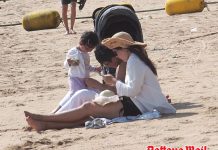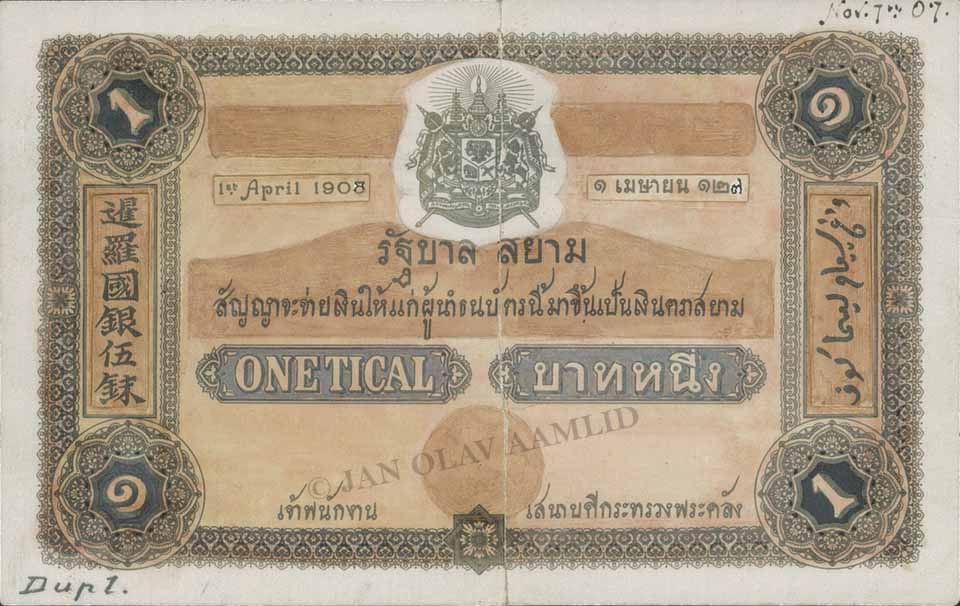
A letter from Thomas de la Rue & Company Limited London (TdlR) to the Siamese Minister of Finance dated 7th November 1907, signed by Chairman Sir Thomas Andros de la Rue, referred to verbal instructions given by a Mr Florio. Emilio Florio was an Italian official at the Siamese Ministry of Finance and was in charge of the Siam Commercial Bank when the bank was established. Mr Florio’s instructions were to prepare a 1-Tical Banknote.
TdlR enclosed in the letter a banknote with the dimensions of 4 ½” x 2 13/18″ (11.43 x 6.91cm). The note was to be printed on watermarked paper and protected against forgery by the TdlR special protective overprint. The price was 1 Shilling 9 Pence per 100 pc for more than 5,000,000 banknotes and 2 Shillings 4 Pence per 100 pcs for 50,000 banknotes. This banknote was never produced.
In the archives of TdlR there was one hand-executed artwork with ink annotation on the upper right margin “Nov. 7th 07” and in the lower left margin “Dupl.” I assume this was a duplicate of the one sent to the Ministry of Finance in Siam.
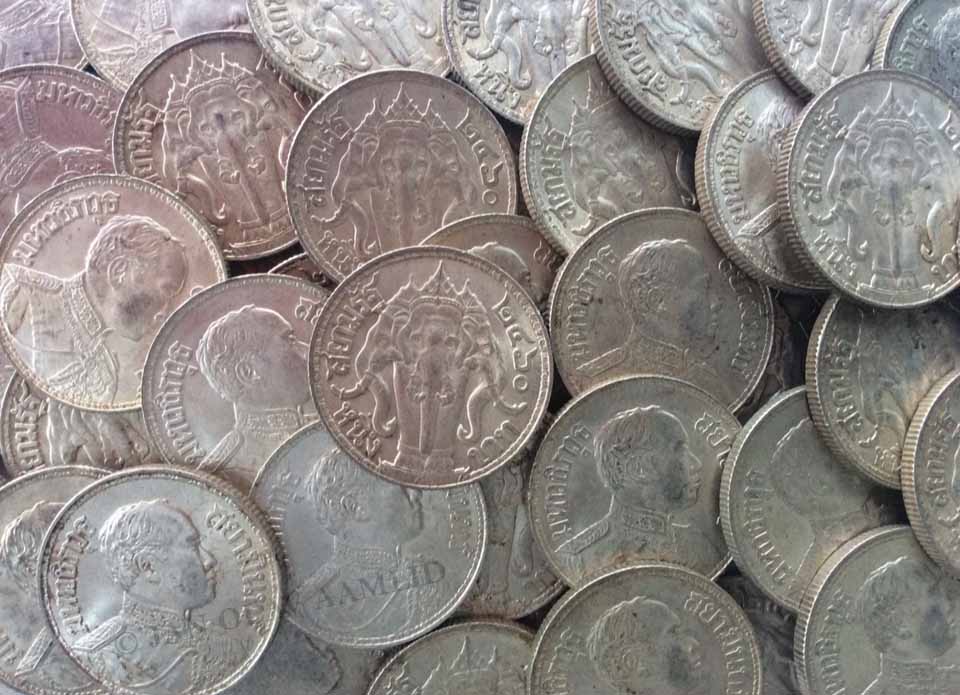
The 1 Baht silver coins were produced until 1918. In 1916, the value of silver in the market rose above the face value on the coins. In 1917 the prospect of producing a 1 Tical/Baht Banknote was brought up and discussed in Washington.
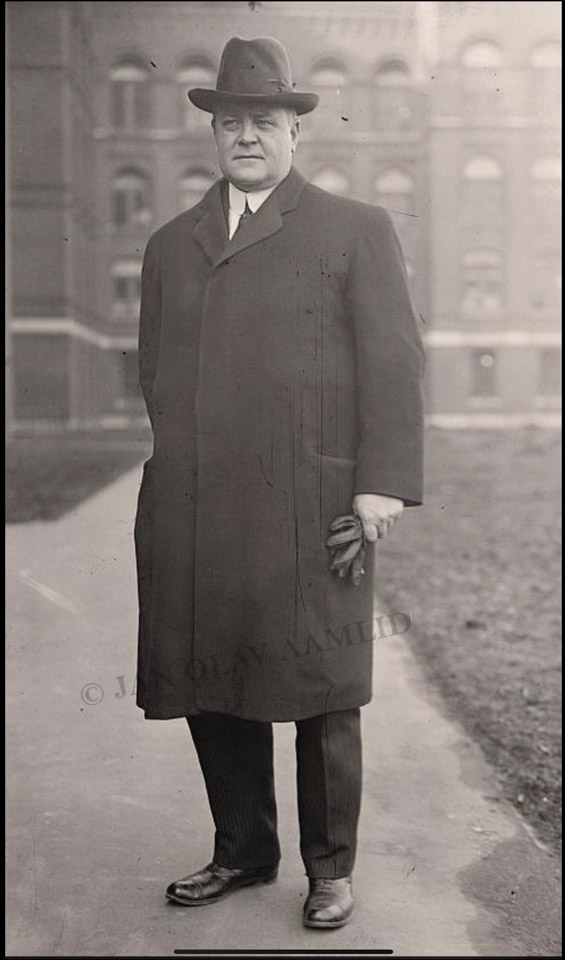
Joseph E. Ralph, who was Director of the US Bureau of Engraving and Printing from 1908–1917, contacted the Director of the TdlR New York office, F. A. Powell, in early October 1917. At this time Ralph had resigned as Director of the Bureau of Engraving and Printing and it was said that he had bought a large quantity of machinery with no authorisation to do so. According to a report published in the New York Post of 5th October 1917, Ralph was to become President of the United States Intaglio Surety Company, a new bank note corporation.
Ralph was very eager to have a meeting with Powell. He sent a telegram to Powell on Saturday 6th of October saying: “I wish you would arrange to come on to Washington at once and see me on a business matter of great importance, if possible come tomorrow Sunday. J. H. Ralph.” During the weekend, J. H. Bagley, Vice President of the American Banknote Company unsuccessfully tried to call Powell on behalf of Ralph. Powell had been away “motoring in the country” during the weekend so he did not see the telegram before Monday morning.
Powell rang Ralph on Monday 8th of October. Ralph wanted Powell to come to Washington immediately as it was most important. Powell agreed to come after Ralph assured him “that it was not the case of our putting up money.” When this was assured, Powell agreed he would come on the night train and meet with Ralph in the morning.
Powell met with Bagley for breakfast in Washington. Bagley knew nothing about the matter except that Ralph telephoned him Saturday to find Powell at all costs, and that there would be six or seven thousand dollars (about US$ 120,000 to 140,000 today) in it for him.
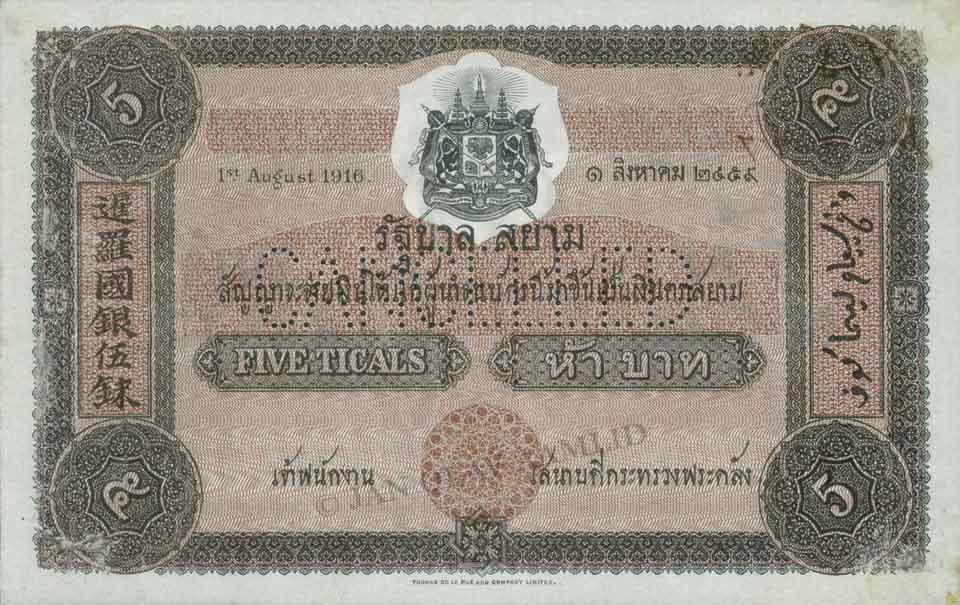
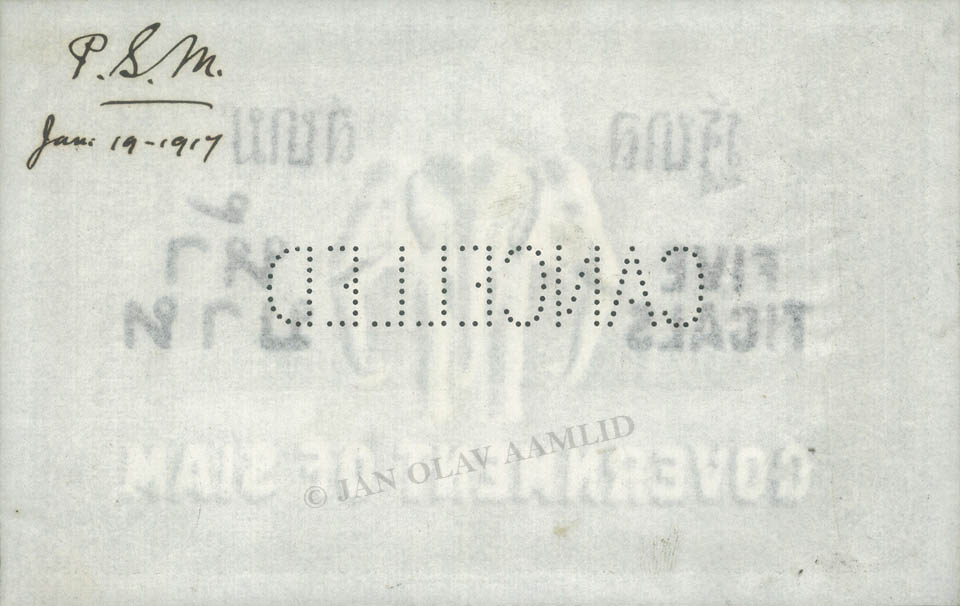
When Powell met with Ralph he was handed the Siamese request: “The Siamese Government needs as soon as possible, ten million One Tical notes according to specimen 5 Tical First Series, Type IV with the following changes:
1: Color is black border below grey ground with eagle instead of arms.
2: Value to be one Tical instead of five, in watermark in the figures and words of value in microscopic lettering in the groundwork.
3: Chinese and Malay lettering inside panels to be omitted.
4: Notes to be numbered in four places 00001 to 100000, with serial letter over number one for the first hundred thousand over two for the second hundred thousand, and so on with corresponding final Siamese lettering and numbering.
5: Printed date will be changed with each new serial number.
6: Notes may be in surface printed. This ensures quick delivery.
It is desired to know what the estimated price will be for the order. What the terms of payment are and the earliest possible date that the shipment of the first million can be made from San Francisco.”
Ralf informed Powell that he could get the contract and have the work done in Buffalo by a new offset process. Ralph had also arranged for the watermarked paper. The numbering boxes were the “chief problem” for Ralph. He thought Powell would be able to get them from England. Powel assumed TdlR in England had none to spare but believed he was able to get them made “over here” in time.
Powel was worried about Bagley and what role the American Banknote Company had in the project of producing the 10 million 1 Tical/Baht notes for Siam. Later Powell had lunch with Bagley where he was told that there was nothing in it for him. However, Powell was worried Bagley would “go nosing about and that the American Banknote Company may get on to it.”
After lunch, Powell went back to Ralph where they were joined by Phya Prabha Karavongse, the Minister (Ambassador) of Siam to the United States, together with his secretary. Powell later wrote in a letter to Stuart de la Rue Chairman of TdlR that it seemed like the Siamese Minister didn’t know that TdlR had produced banknotes for Siam for many years already nor did they know about their contract.
In any case the Siamese Minister informed the Americans that 1 Baht banknote was a special war issue and was urgently needed. They presumed that England was unable to execute the production in time, hence they were exploring the possibility of producing the 1 Tical/Baht in America.
Ralph informed the Siamese delegation that the price would be very high because everybody was very busy and that delivery would take place 45 days after the contract was signed.
Another meeting was to take place in a few days and Ralph would present a definite quotation. More details about the design were to be obtained by telegram from Bangkok and one of the new Five Tical notes with the new design had to be obtained from England.
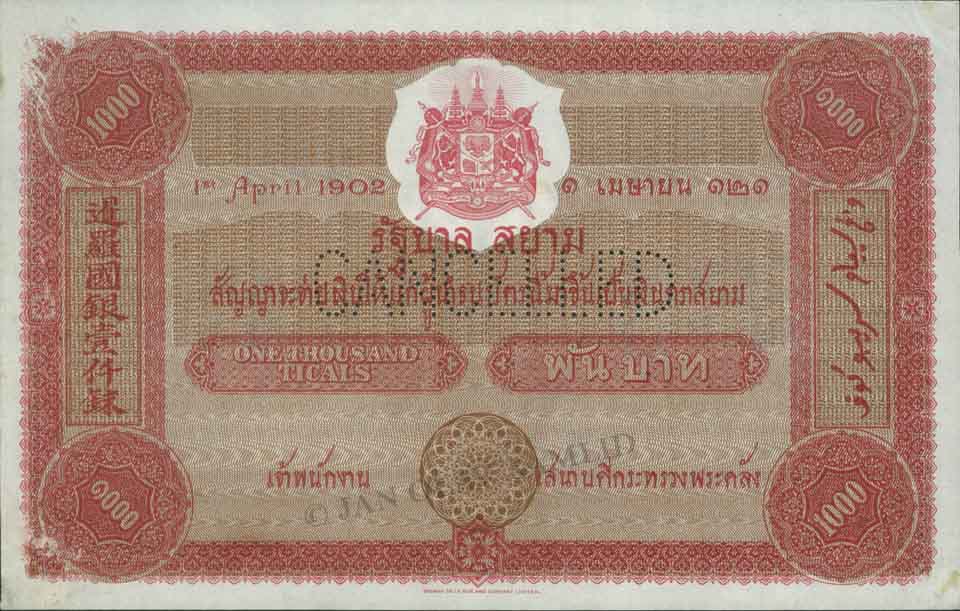
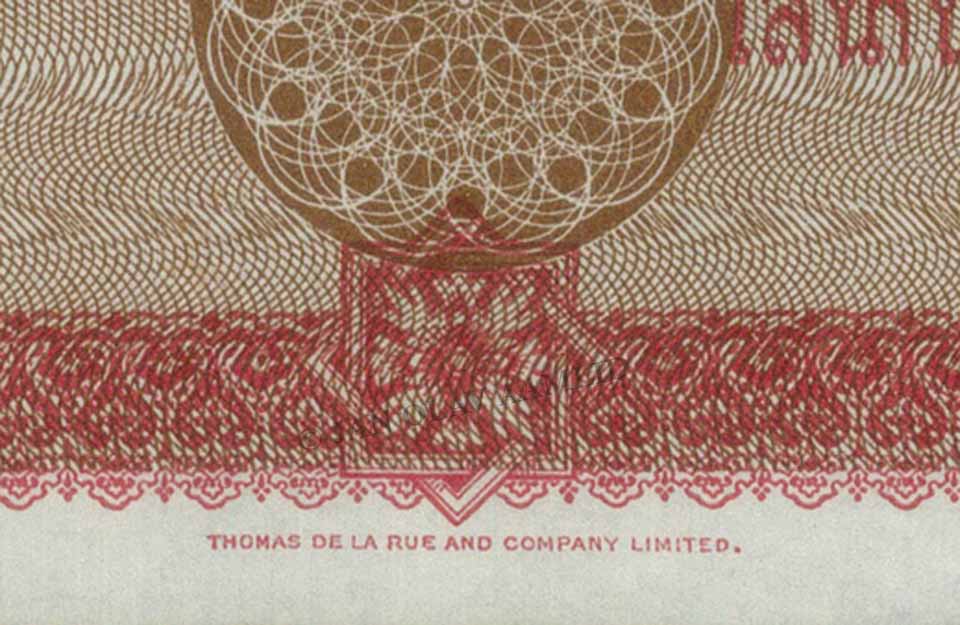
At this time, TdlR in London was charging 36 shillings 8 pence for 1,000 pcs of the 5 Tical note. They suggested that the Director of TdlR, New York should be asking not less than US$ 7 per 1,000 notes plus the cost of the numbering boxes. On the notes “THOMAS DE LA RUE AND COMPANY LIMITED, LONDON, NEW YORK” could appear on the lower margin of notes. At that time, all the First Series banknotes had “THOMAS DE LA RUE AND COMPANY LIMITED” printed in the lower margin in small letters.
The Director of TdlR, London sent a letter to Powell in New York dated 11th October informing him that in 1907 a 1-Tical note was sent to Thailand with numbering in two places. TdlR, London did not have any numbering blocks, as they were full up with numbers for the 5-. 10-, 20- and 100 Tical notes. It was also stated that TdlR, London had no formal contract and feared it was not much use making one.
On the 1st of November, Powell, TdlR, New York, sent a telegram to TdlR, London saying: “Americans quoting one Tical notes copper plated delivery six month comma price slightly over one cent each comma overdraft ten thousand dollars-Powell.” In 1917 US$10,000 is equal to about US$200,000 today.
The day before, on the 31st of October 1917, a meeting took place in London between H.E. Phya Sudham Maitri, Minister (Ambassador) of Siam to the United Kingdom, A.J. Hayne, Director of TdlR, and Stuart de la Rue, Chairman of TdlR. They discussed the production of the 1 Tical/Baht note. In the meeting it was mentioned that the Director of TdlR, New York had received an enquiry to manufacture this issue and had proposed to send a quotation to the Siamese Government.
TdlR was of the opinion that the work should be done in London as the notes were urgently needed. TdlR, London submitted a specimen that they were sure would meet with the approval of the Siamese Government. Delivery would take place six weeks after the receipt of final instructions. The notes would only be numbered in two places in Latin characters. The problem was that the numbering boxes had to be specially manufactured and there could be a serious delay if Siamese numerals were required. The estimated cost could be GBP 1 per 1,000 pcs. GBP 1 in 1917 is equivalent to app. GBP 70 today.
The day after the meeting, TdlR sent a telegram to the Minister of Finance in Bangkok informing them about the expected time of deliveries and the price. TdlR, London had suggested to the director of their New York office that to produce the notes in the United States, they should quote a price that was 50% higher than that quoted by TdlR London. Eventually the price to produce the banknotes in England was adjusted upwards by 45%.
On the 5th of November, H.R.H. Prince Kitiyakara, Minister of Finance, sent a telegram to H.E. Phya Sudham Maitri which said: “I have received a telegram from de la Rue offering to supply 10 million 1 Tical Notes for about GBP 1 per 1,000 pcs, delivery to commence in 6 weeks after the receipt of final instructions. If it is so, you may place an order but Contract must be signed with provisions for completion in the stipulated time and with penalties for delays.
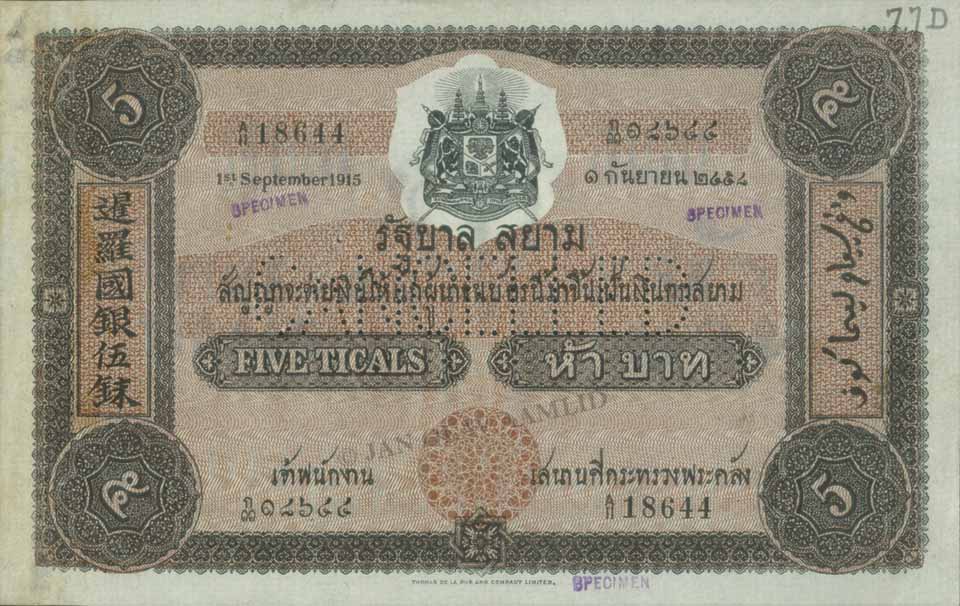
“The 1 Tical Notes to be produced in the same size as the 5 Tical Notes with the following changes: Colour black border pale grey ground. Garuda instead of Arms, value 1 Tical instead of 5 Ticals in watermark in figures and words of value and in microscopic lettering in the groundwork also. Chinese and Malay lettering in side panels to be omitted. Notes to be numbered in 4 places 00001 to 100,000. Z over 2 for second 100,000 and with corresponding final Siamese letters and numbers. Printed dates will change with each new serial numbers. Please inform me by telegraph immediately what arrangements you make and please send a copy of the contract.”
The telegram was received on the 6th of November and another meeting took place the next day with H.E. Phya Sudham Maitri, Minister (Ambassador) of Thailand to the United Kingdom, the Chairman of TdlR Stuart de la Rue, and the Director of TdlR A.J. Hayne in attendance. At the meeting, the chairman suggested printing the notes on un-watermarked paper, numbering them four times in Latin figures, saying that it would be quite an impossibility to obtain watermarked paper and the Siamese numbering boxes in time to furnish the notes.
They would make the transition to printing on watermarked paper and include the Siamese numerals as soon as possible. H.E. Phya Sudham Maitri was instructed to follow the Minister of Finance’s instructions per their telegram of the 5th of November. He therefore decided to send a telegram to Bangkok to inform them of the situation.
On the 7th of November, the Chairman of TdlR, Stuart de la Rue, sent a telegram to Director Powell, TdlR New York: “Avoid all guarantees to Siam as to the time required for Siamese numerals – Stuart.” This was probably done so the Americans would not compete for the contract, as the problem for them would be to print the notes with Siamese numerals within the timeframe. TdlR, London had the same problem, as well as obtaining the watermarked paper.
H.E. Phya Sudham Maitri informed TdlR, London on the 10th of November that the Minister of Finance, Bangkok, had requested him to inform them that Siamese numbering on the notes is absolutely essential. He would also be glad to know when TdlR would undertake to commence the delivery of the notes with the watermark and the Siamese numbers and how long it would take to execute the order.
A few days later TdlR, London informed His Excellency that they could deliver the notes on watermarked paper and numbered twice in English and twice in Siamese at the rate of 100,000 notes per week, 9 weeks after the final instructions were received. The price would be higher as the price was based on a smaller note and on un-watermarked paper. The price quoted before was 20 Shillings and the amended price was 32 Shillings and 6 Pence.
H.E. Phya Sudham Maitree sent TdlR a draft agreement on the 17th of November. There were several minor alterations made by TdlR, London concerning delivery and penalties for not delivering in time.
TdlR consulted with the law firm Bristows, Cooke & Carpmael in London. The problem was that the contract stated that TdlR would not be responsible for delays in manufacture of the said notes or the delivery thereof due to: “strikes, lockouts, labour troubles, fire, war, shortage of or delay in supplies of paper or other raw materials, accidents to or shortage of or delay in supply of tools, plant or machinery, or to any other causes whatsoever preventing or hindering in the manufacturing or delivery.”
Several different drafts were exchanged until H.E. Minister Sudham Maitri sent a letter on the 23rd of November wherein he could agree that TdlR should not be responsible for non-delivery owing to “strikes, lock outs, fire, acts of the enemy and such like delays over which you have no control.” The Minister also stated that he was not authorized to waste time in this matter. He wanted to know if TdlR, London was definitely prepared to sign the agreement that would bind them to the time of delivery.
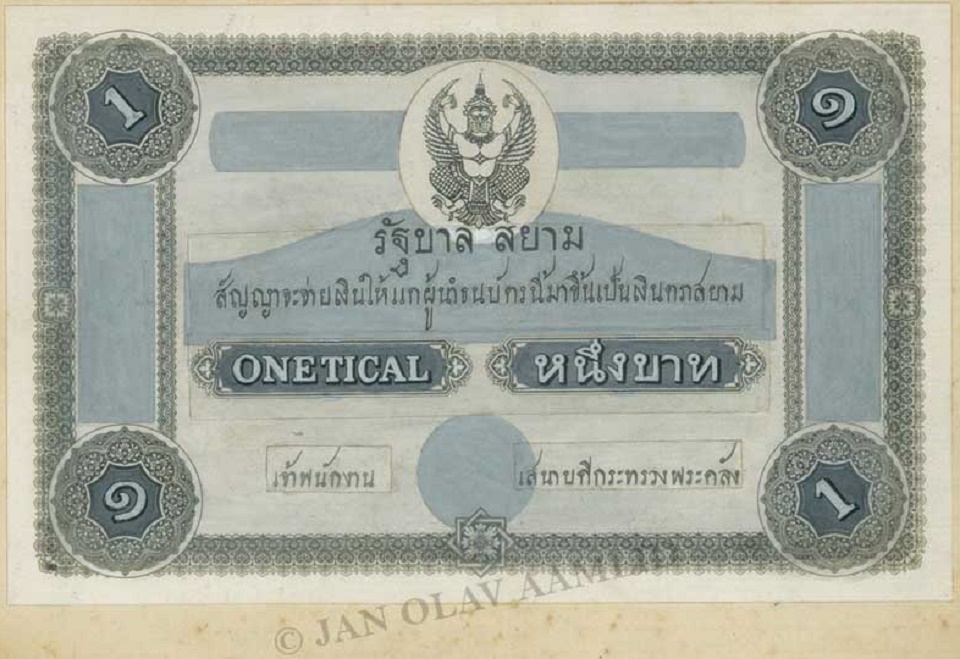
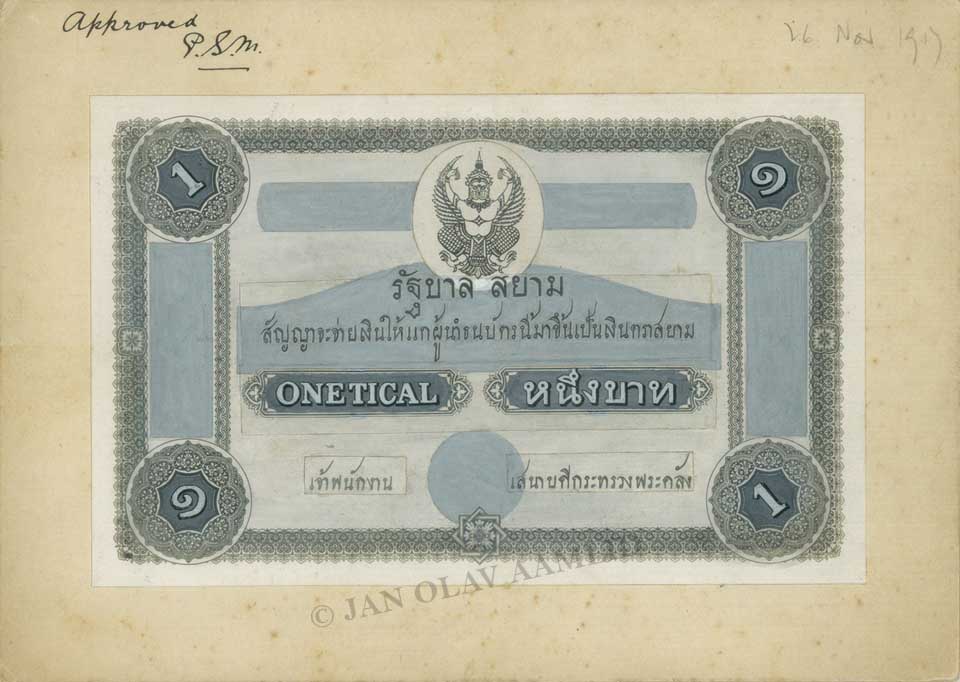
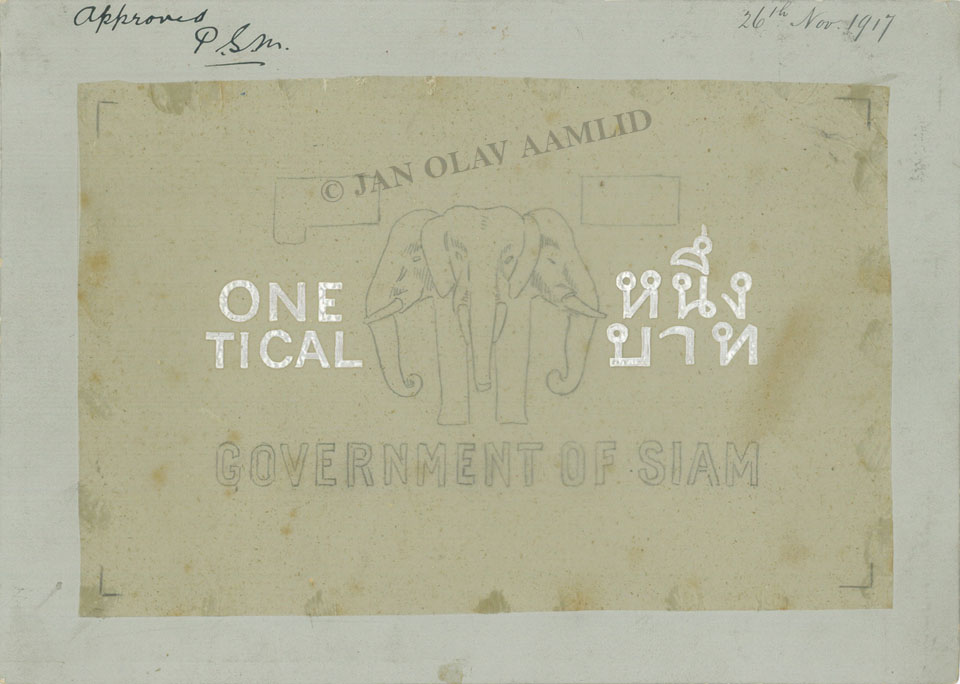
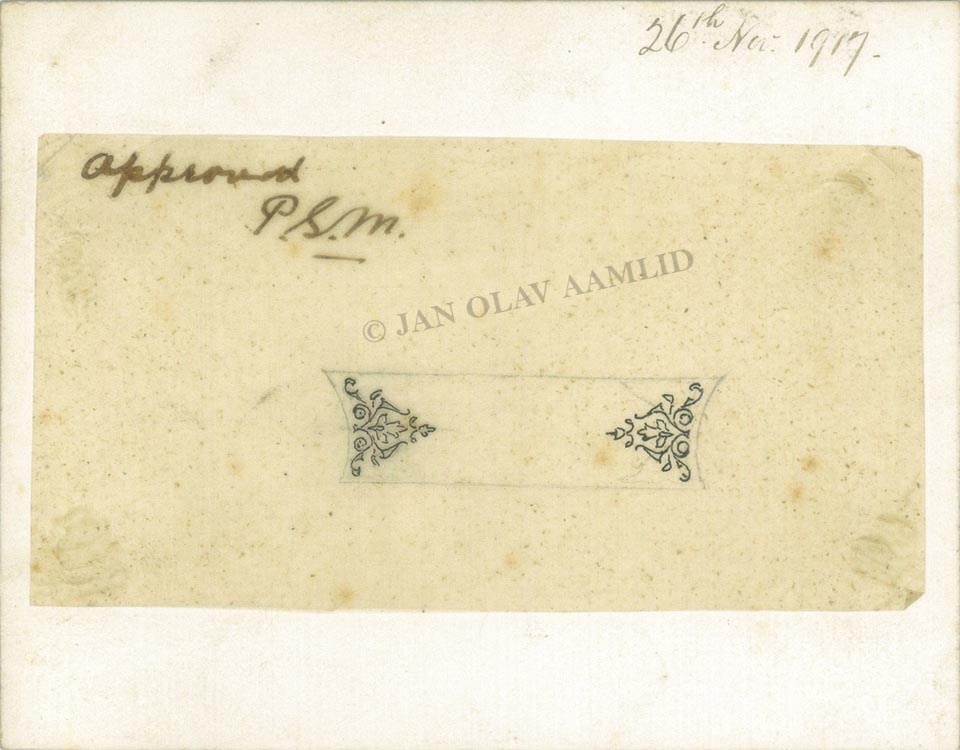
A few days later, on the 26th of November, TdlR, London presented H.E. Minister Sudham Maitri with suggested artwork for the One Tical/Baht banknote, the changes in the side panels showing that the Chinese and Malay lettering were omitted and a specimen of the watermarked paper. They were all initialled as approved.
TdlR, London on the 29th of November, sent the signed agreement to the Secretary of the Siamese Legation in London. The Minister kept one copy of the agreement and returned one signed copy to TdlR, London the next day.
On the 4th of December 2017, TdlR had prepared the dates and prefixes in Latin and Siamese to be used for the 1 Tical/Baht notes. These were signed as approved by Minister Phya Sudham Maitri on the 5th of November. The first banknotes were to be dated 1st, 8th, 15th and 22nd of February 1918 and the first prefixes would be from Z/1 to Z/28. The prefixes, dates and numbers would be in Latin and Thai.
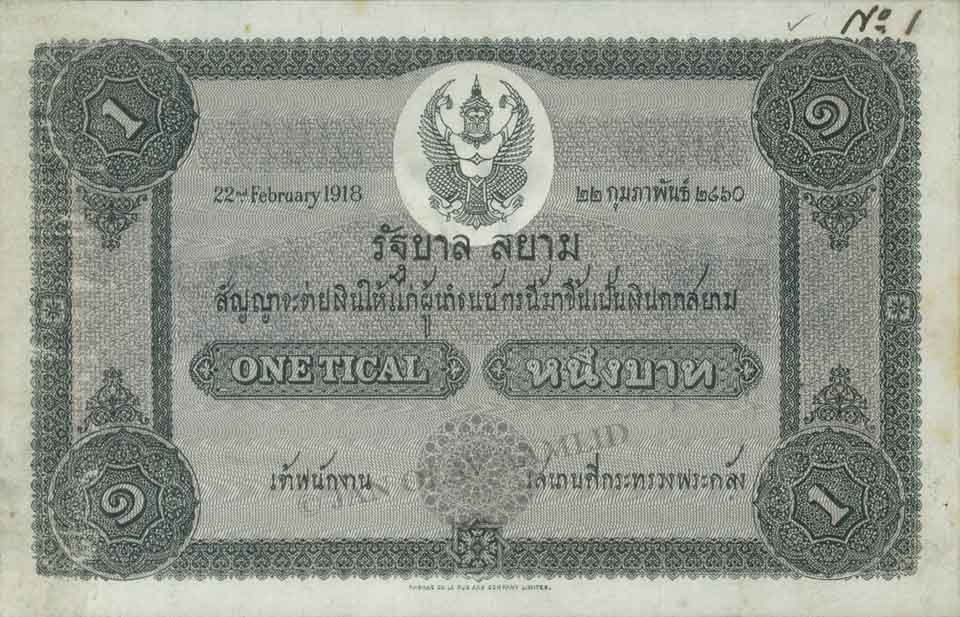
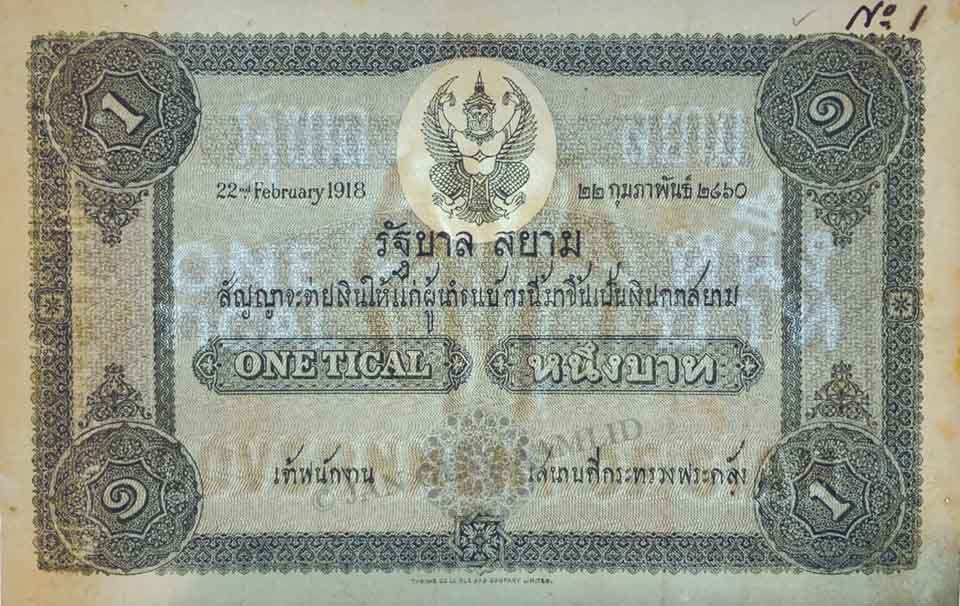
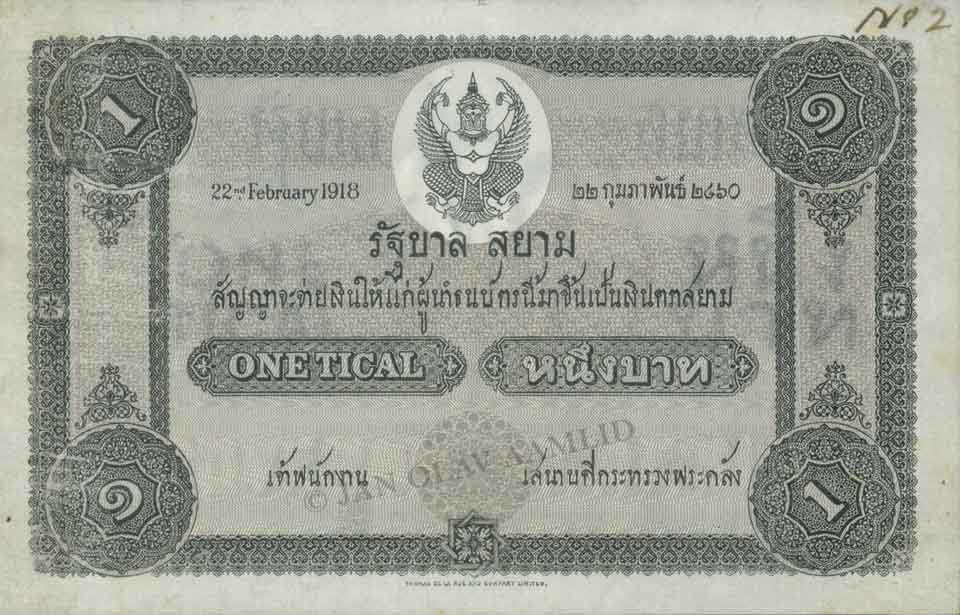
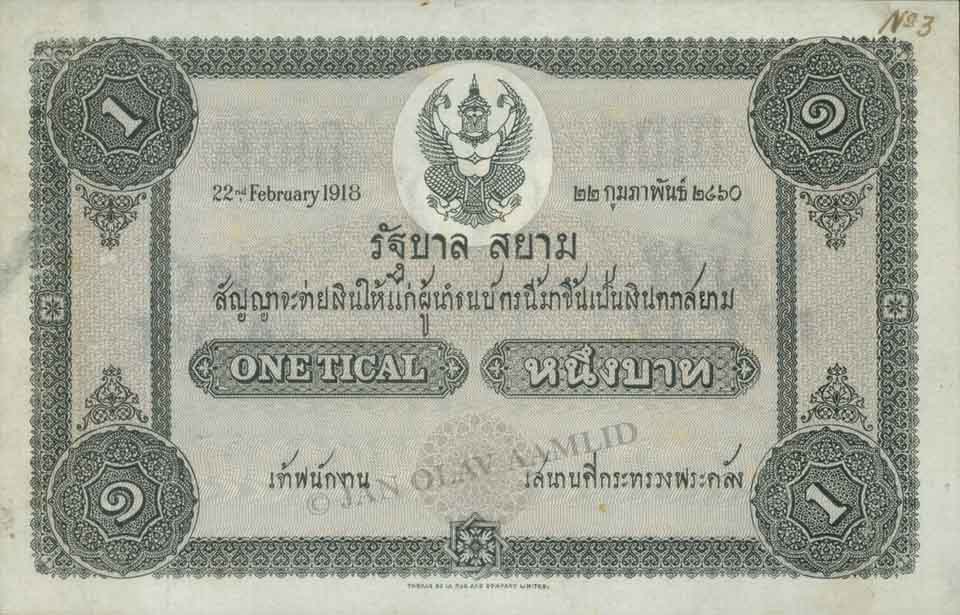
TdlR, London was already preparing to produce the banknotes even while negotiations were taking place. They must have been quite confident that they would get the contract. Very soon after, on the 19th of December, TDLR sent the Siamese Legation in London three specimen of the 1 Tical/Baht banknote. All were printed on the paper prepared for this value and printed in black and overprinted in various shades of grey. TdlR was of the opinion that No. 1 was the most protective against forgery by photography. This was the one H.E. Phya Sudham Maitri approved.
It is a question what actually happened prior to the negotiations in Washington. By this time Joseph E. Ralph had just resigned as Director of the US Bureau of Engraving and Printing, and was to be president of a new bank note corporation. J. H. Bagley, Vice President of the American Banknote Company, was also involved in the negotiations even though his role was not clear. He had stated that there would be six or seven thousand dollars (about US$120,000 to 140,000 today) in it for him according to F. A. Powell, the Director of TdlR New York office.
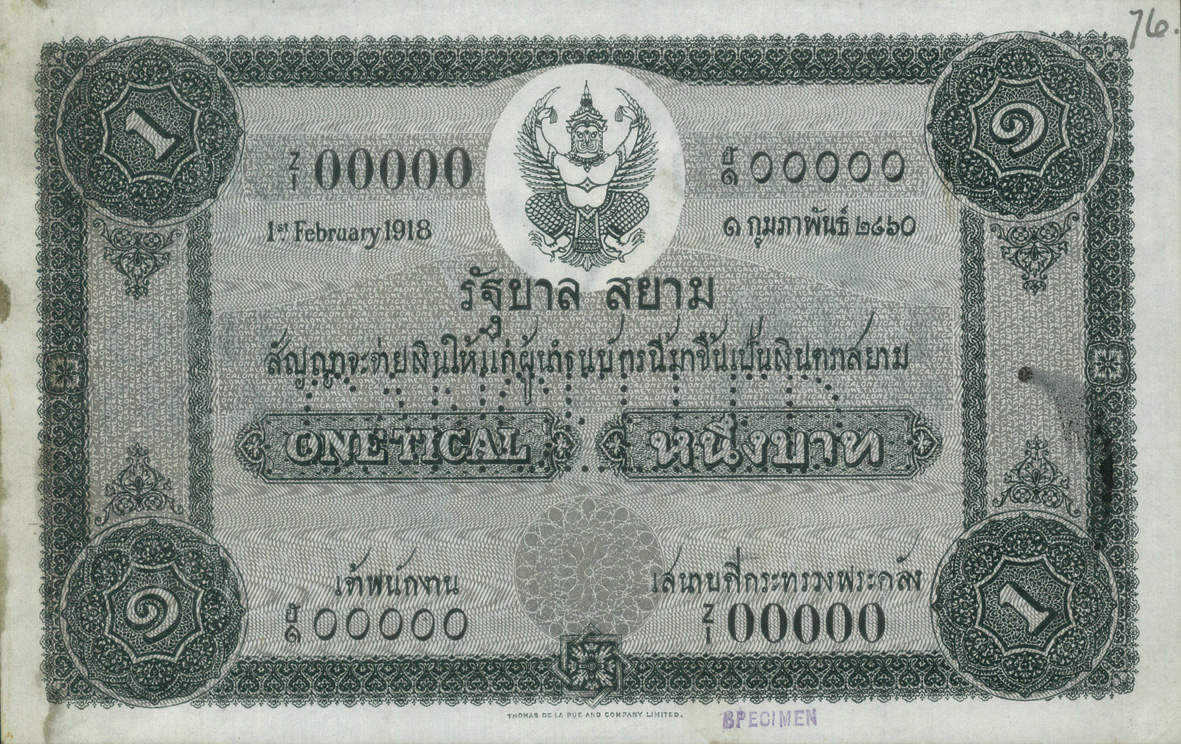
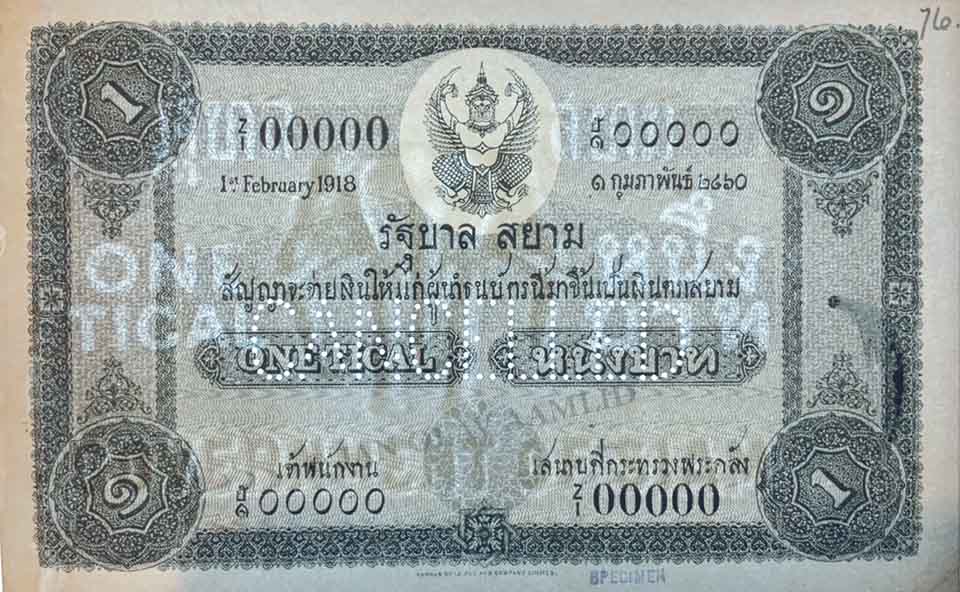
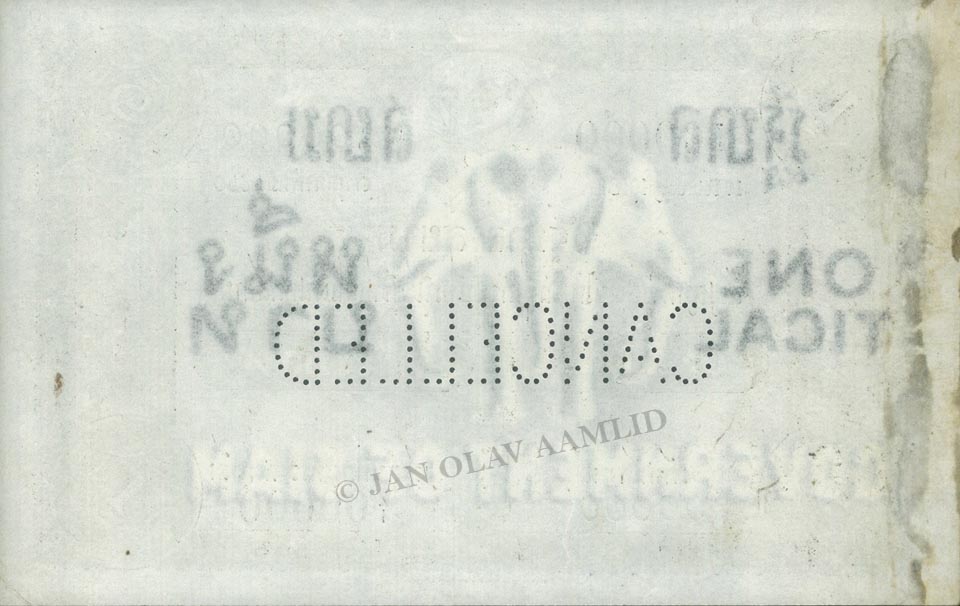
Phya Prabha Karavongse, Minister (Ambassador) of Siam to the United States, (1913-1922) did not know much about the project when he attended the meeting in Washington. Probably it was Ralph and Bagley who had contacted Siam in order to produce banknotes for Thailand. Ralph was going to be the Director for a new Banknote Company and Bagley was running to TdlR, a competing Banknote Company. The reason Powell was contacted was because they had problems getting the numbering boxes with Siamese numerals and thought he could help.
In any case, TdlR, London got the contract and fulfilled all the requirements as requested by the Siamese Ministry of Finance. The 1 Tical/Baht banknote was announced in the Royal Gazette on October 3, 1918.
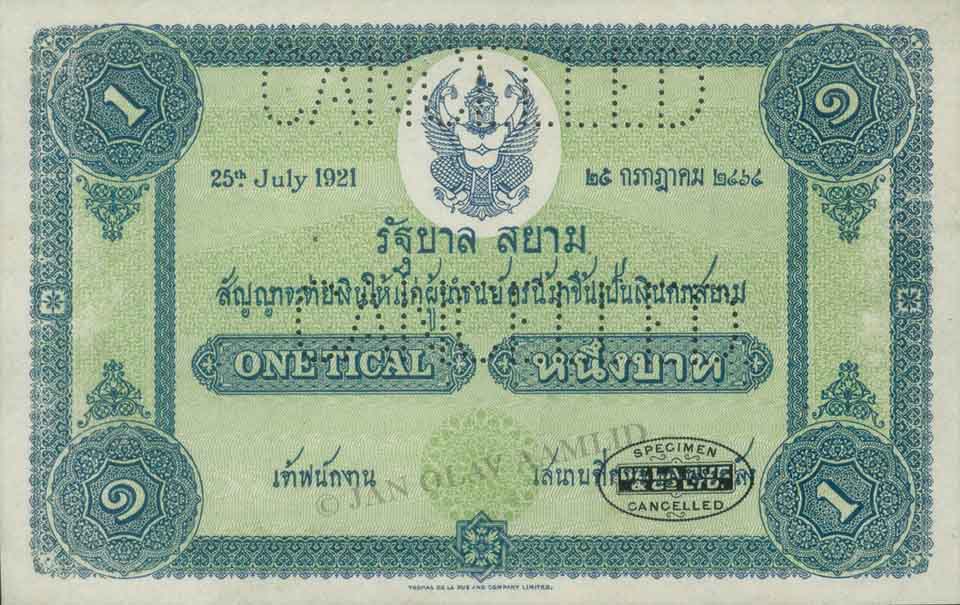
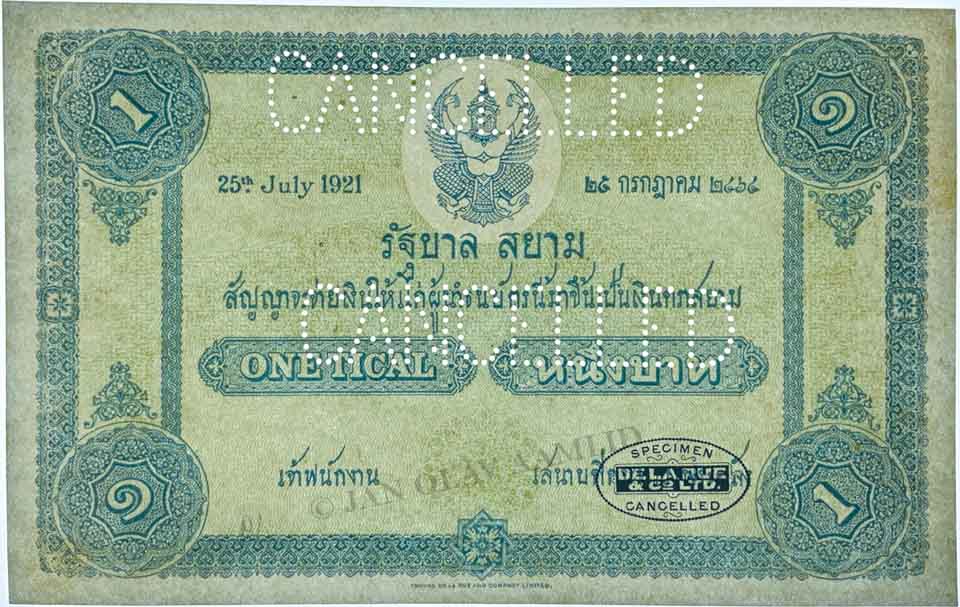
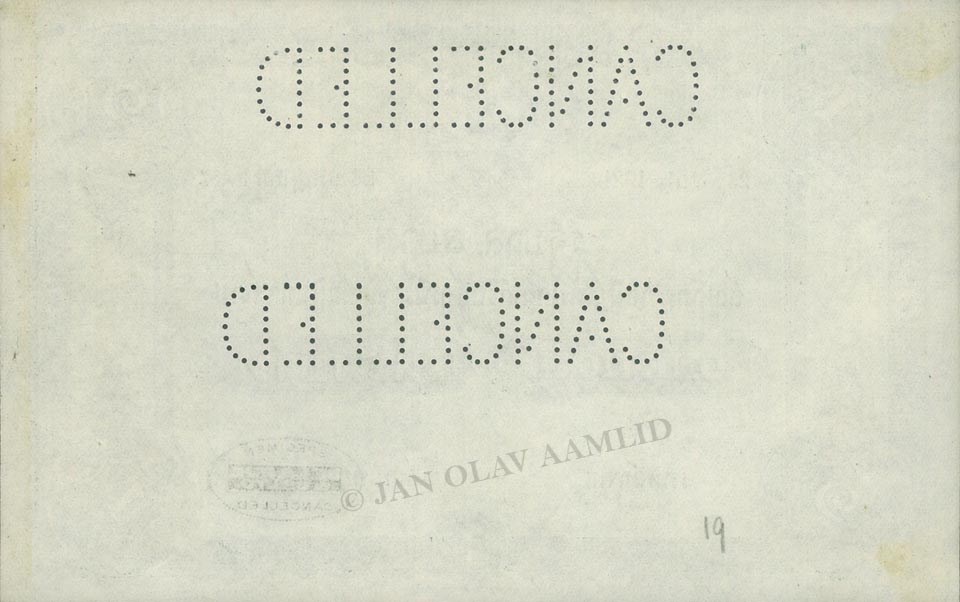
For the First Series very few colour trials were produced. This rare colour trial 1 Tical/Baht is printed on normal paper. The reason for this was probably because the watermarked paper had to be bought from a paper manufacturer and was expensive.
The main purpose for a colour trial was to show colour varieties for the customer or a potential customer. This colour trial was printed with light green background and bordered by a blue frame. It does have the perforated “CANCELLED” in two places. This was the very first time that an oval stamp in black ink with the words “SPECIMEN DE LA RUE CANCELLED” was imprinted on a Siamese banknote.
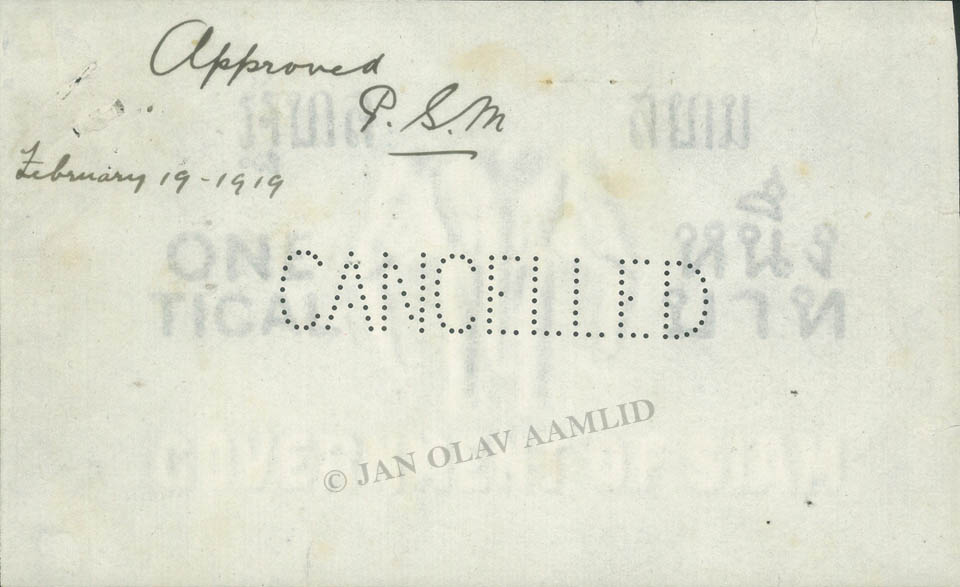
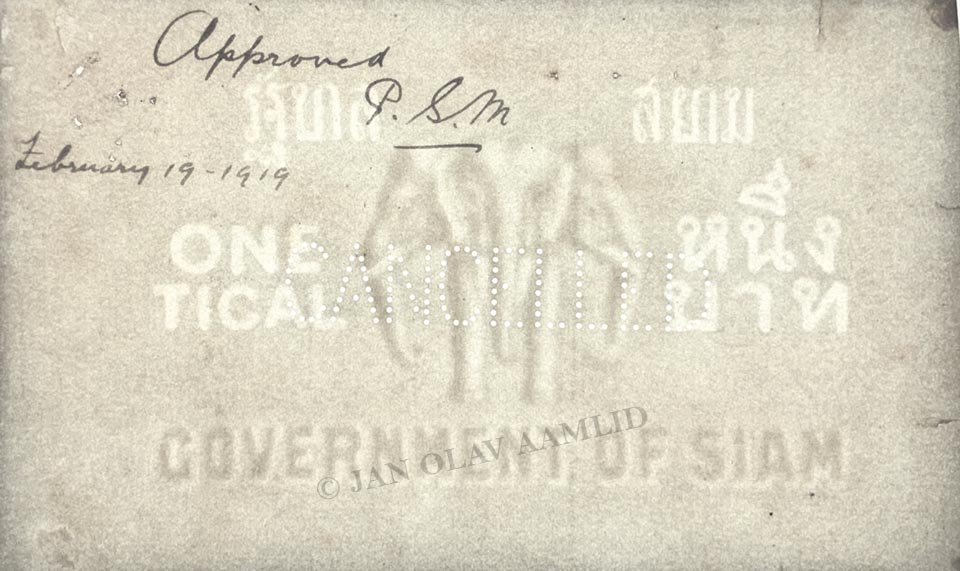
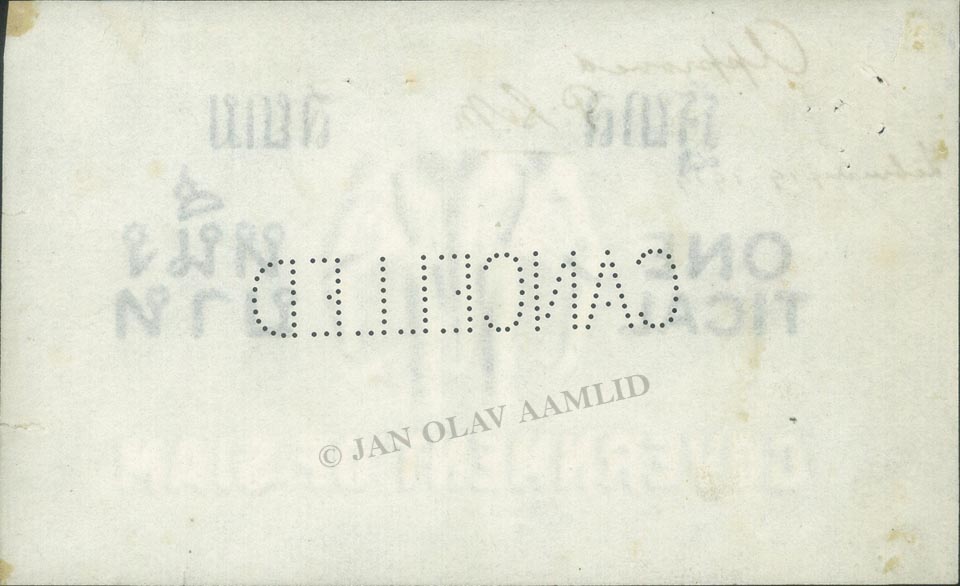
Because there was great demand for the 1 Tical Banknote, H.R.H. the Minister of Finance Prince Kitiyakara wanted to place another order for Ten Million 1 Tical Banknotes on the 30th of January 1919.
But if TdlR could not guarantee substantial and regular deliveries H.R.H. Prince Kitiyakara would regrettably be compelled to place the order elsewhere. To hold on to the contract, TdlR guaranteed the delivery of 100,000 notes in 4 weeks, 150,000 in 5 weeks and after this 250,000 per week. To execute the order TdlR had to instruct the Paper Maker to produce and deliver the watermarked paper for the order on time.
The watermarked paper also had to be approved by the Siamese Minister in London and this was initialled as approved on February 19, 1919.
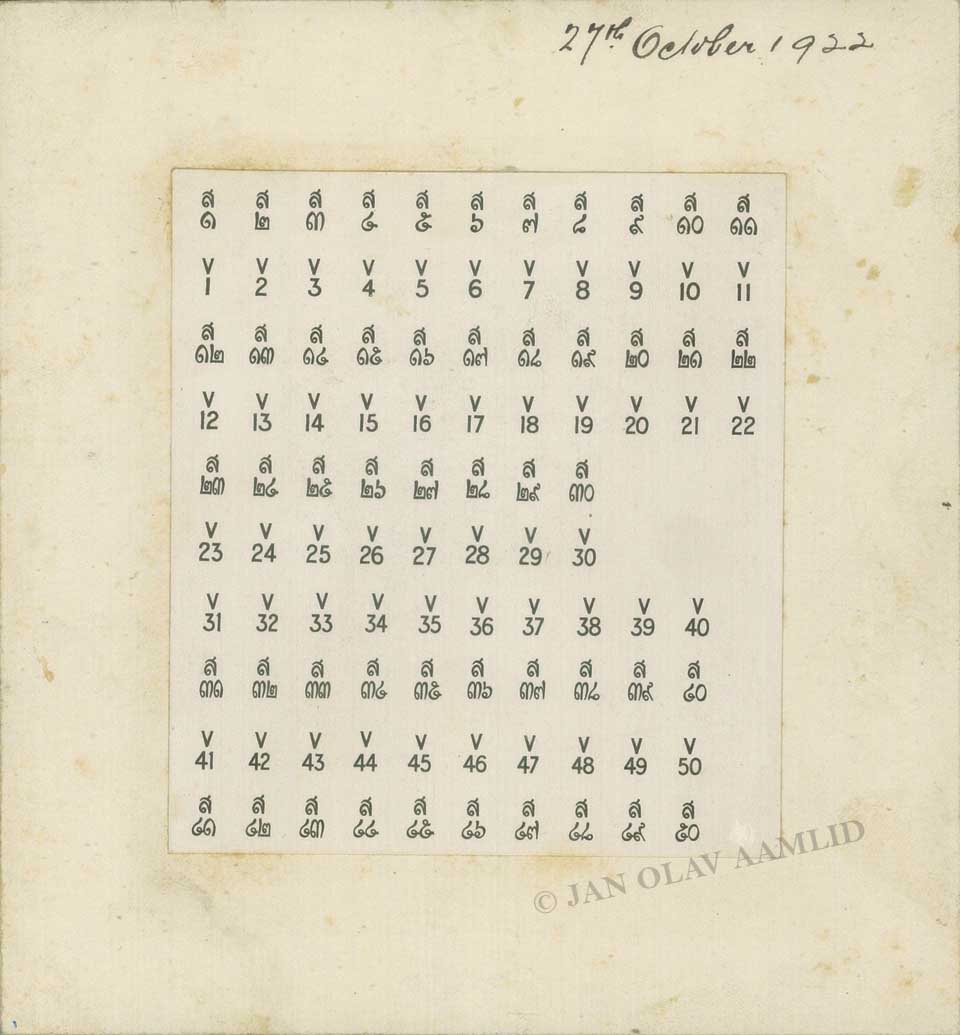
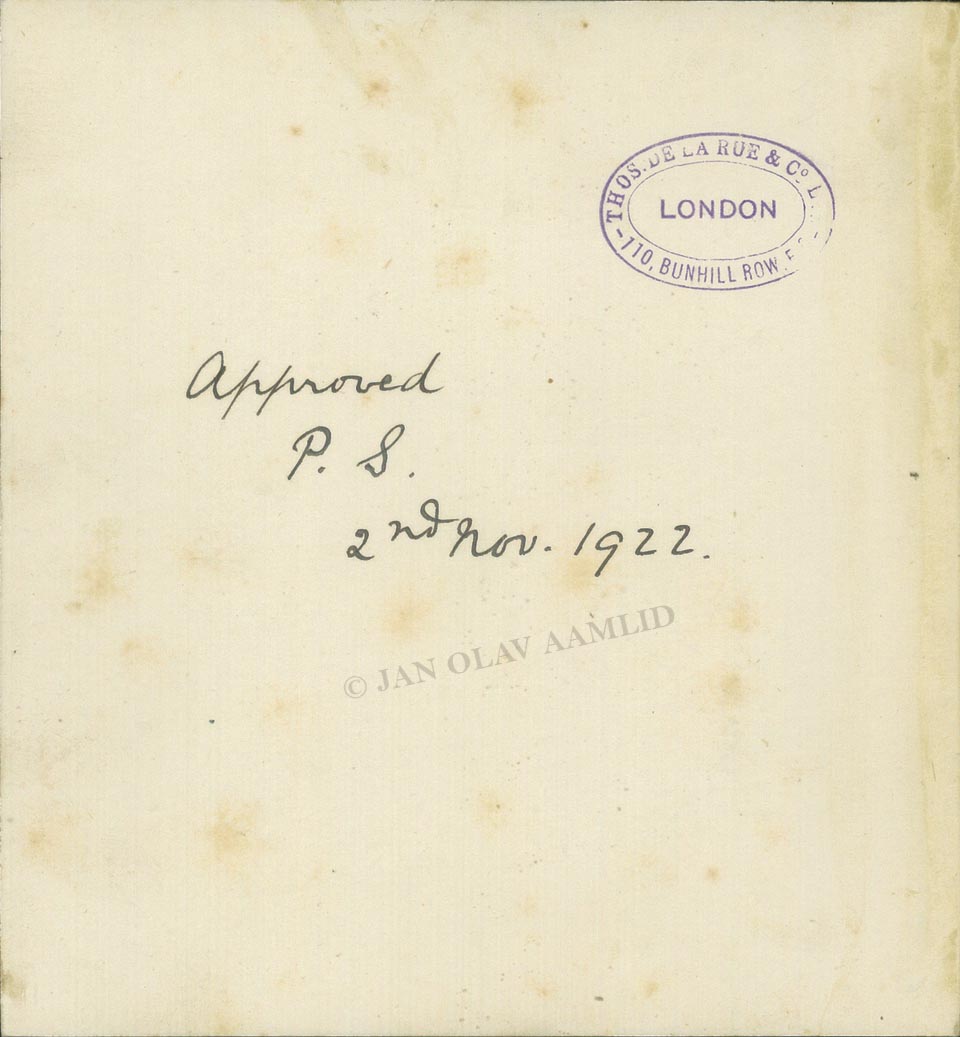
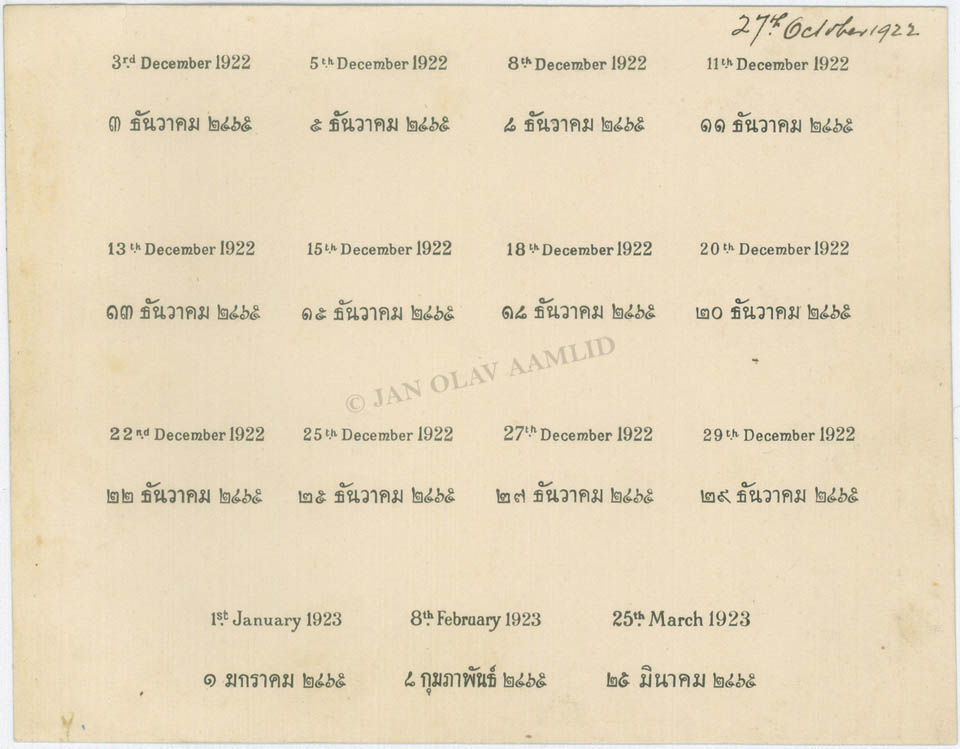
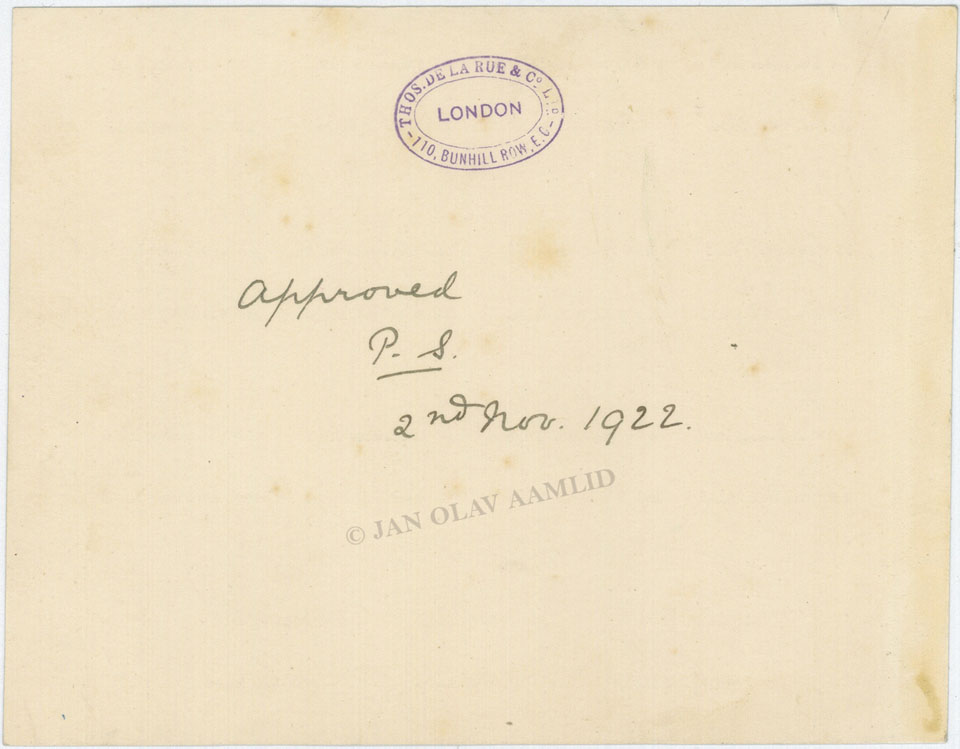
For the 1 Tical/Baht First Series several prefixes were used, U, V, W, X, Y, and Z. Under the prefix was a number from 1 to 100. The prefix, numbers and dates were to be printed in Latin and Thai. They were printed on cardboard and were to be approved by the Siamese Legation in London. This shows the prefixes from V/1 till V/50. The other card shows the dates to be used, 3rd December 1922 till 25th March 1923. The cards were dated by TdlR 27th October 1922 with the approval signature of the Siamese Charge d‘ Affaires in London, Phra Sanpakitch Preencha dated 2nd November 1922 on the reverse.
The specimen banknote dated 20th December 1922 is also initialled as approved by the Charge d‘ Affairs dated 14th December 1922.
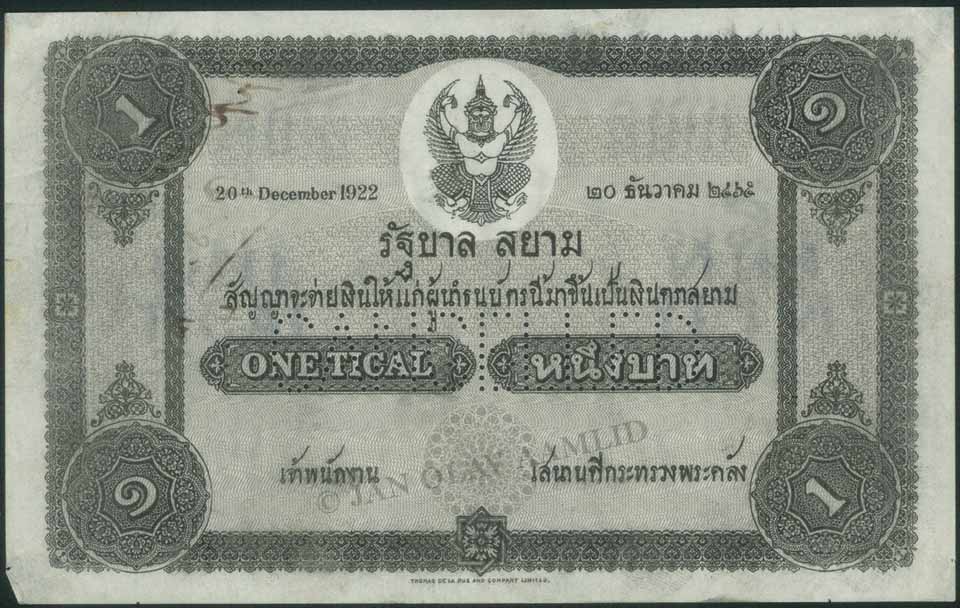
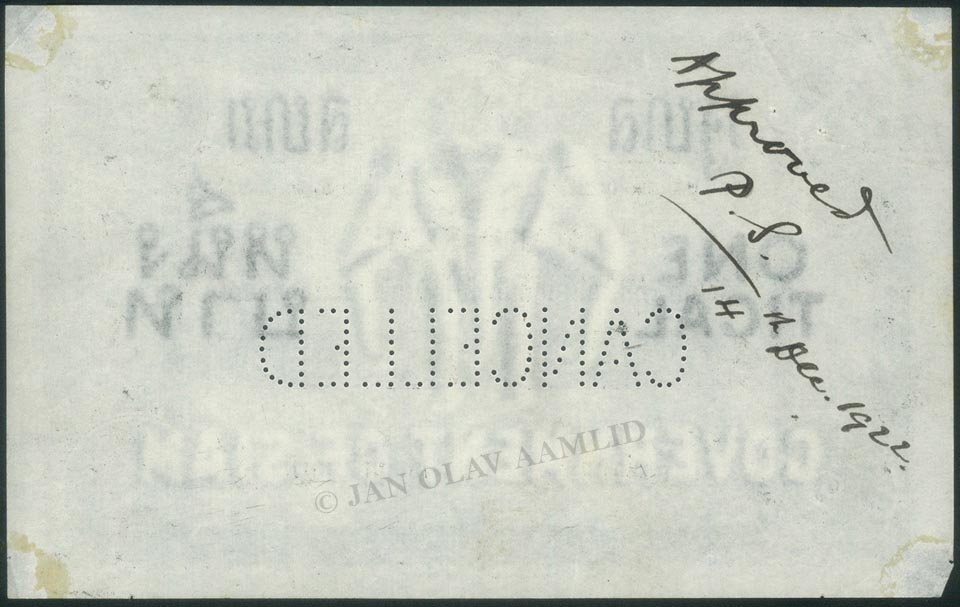
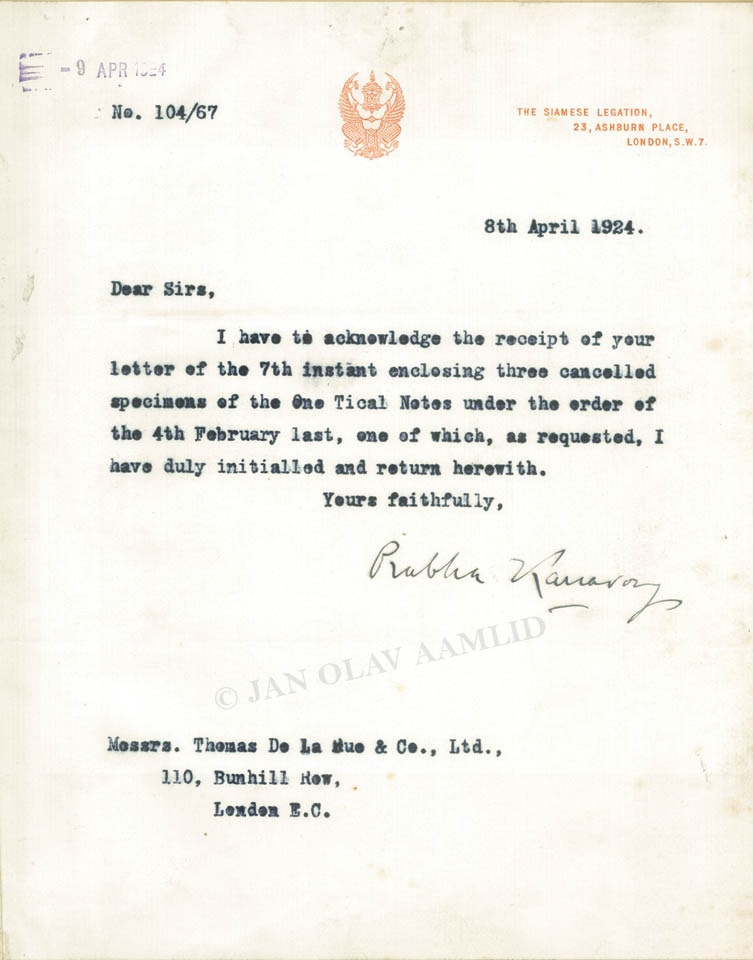
On the 4th of February 1924 the Minister of Finance placed an order for Five Million 1 Tical Banknotes. They were to have the prefix “U”. This is one of the banknotes which was part of this order. The letter accompanied the approved banknote when it was returned to TdlR from the Siamese Legation in London. It is signed by Phya Prabha Karavongse, the Siamese Minister (Ambassador) to United Kingdom (1923-1926). The banknote is initialled as approved by the Minister. This banknote is probably the first banknote in a new printing run. Another order was placed on 21st October 1924 with prefix to be U/51 to U/80. The last date for the 1 Tical/Baht First Series is 29th September 1924. On the 21st July 1925 the Second Series were announced.
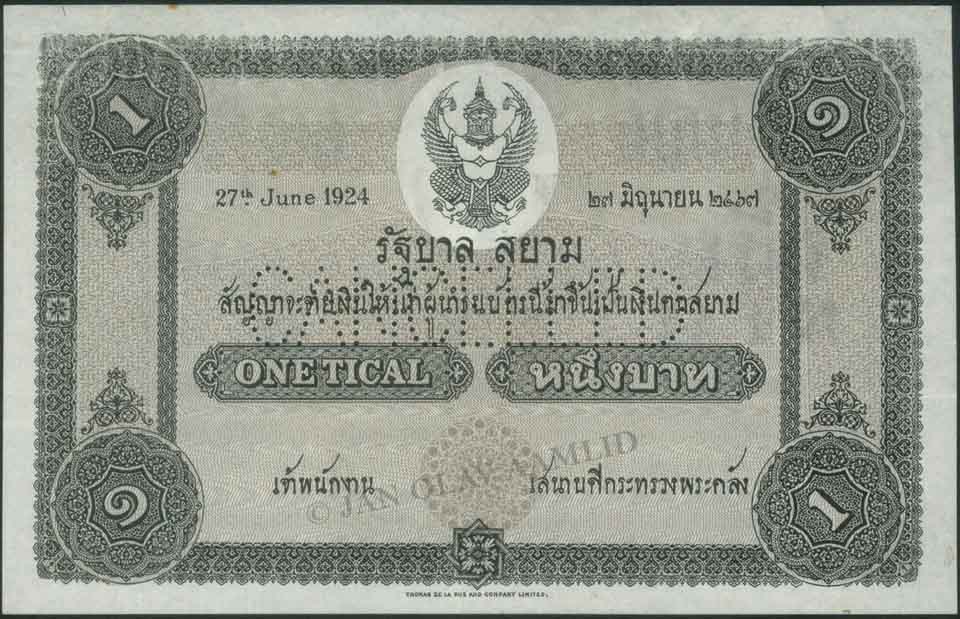
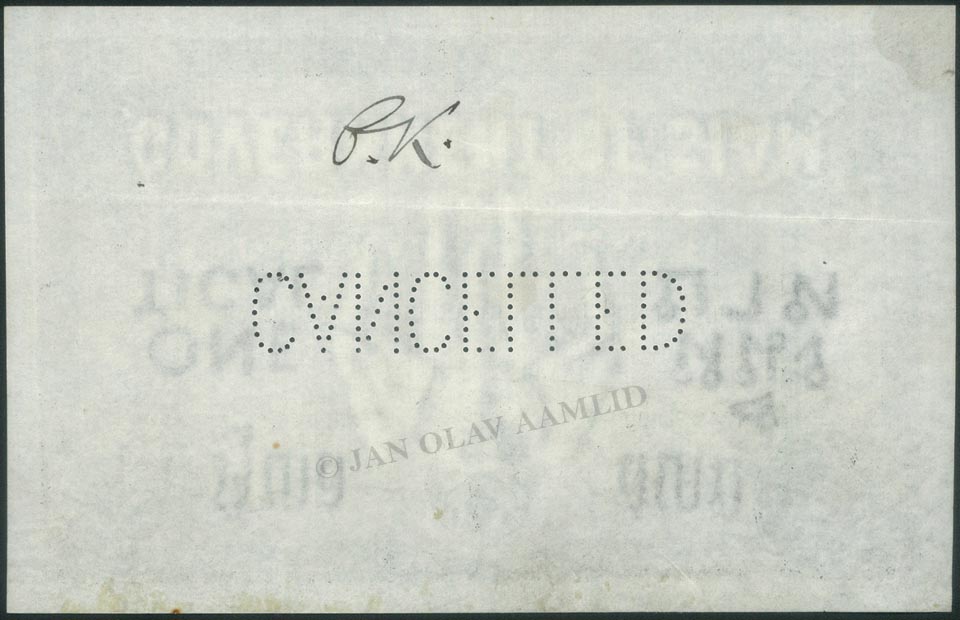
References:
-The archives of Thomas de la Rue & Company, Limited, London
-Bank of Thailand “Centenary of Thai Banknotes 1902-2002”
-Somchai Saeng-ngern. “Thai Banknotes Catalogue, Complete and Updated Edition”
-All illustrations from the Jan Olav Aamlid collection
Copyright @ 2021 All rights reserved by Jan Olav Aamlid



